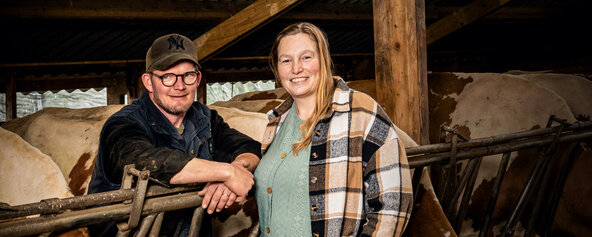
“We need to liven this place up!” Stef and Lenie of De Tienmorgen farm decided 30 years ago. At the time, they had 60 dairy cows on their remote site in the Dutch province of Noordbrabant. Life was good but they wanted to brighten things up and have a little more fun. But what is the recipe for a busier farm? Their aim was to appeal to people and encourage them to stick around a little longer than for just a brief guided tour. Perhaps they could persuade visitors to stay and enjoy the hustle and bustle of farming life and the tranquil countryside for days, maybe even weeks. They went ahead with their idea and wound up opening the first campsite on a dairy farm in the Netherlands.
Today, it is mainly De Tienmorgen’s daughter Hanneke von Overbeek-Gosens who manages the house and farm. Together with her father Stef, husband Richard, brother Huub and sister-in-law Laura, she runs the mixed operation in Beers, the Netherlands. Her parents’ campsite managed to not only attract more guests and make life more fun, they also found the site would work as a therapy farm. Eventually, schools with children with special needs heard about the farm and began sending youngsters with mental or physical handicaps to benefit from the country air. The farm is now an official recreation site in the Netherlands.

Ever since, dairy farming has become a sideline, though it is still significantly more than a hobby. “The dairy farming has to be profitable as an independent business,” says Hanneke. “We really had to figure all this out in the early days, especially because we produced so little milk,” she recalls. In 2014, they decided to become members of DOC Kaas and have been providing their milk ever since. “DOC Kaas was very supportive and collaborating together went really well right from the outset.” Her husband Richard von Ovebeek-Gosens meanwhile oversees standards, making sure the milk is of the highest quality level. The dairy cattle farm, with 30 dairy cows and 30 calves, is now a serious business. The red Holsteins are strong, well-developed and beautiful – no wonder the family does so well at livestock shows. “Our highlight was in 2019, when we entered in the European championship and won in our group,” Hanneke says proudly. She recently presented two winning cows at another show.
The red Holstein cows produce around 10,500 kilos of milk with 3.77 percent protein and 5.10 percent fat per year, on average. “We are not aiming for a maximum production target,” says Richard, who nevertheless provides nearly three tons of milk per year. The cows eat 75 percent green fodder and 25 percent corn, plus the animals get as much hay as they need. Richard transports the silage to the feed fence, and the assistant farmers provide the corn in a wheelbarrow. The cows get concentrated feed through a feed concentrate box, to ensure they always receive the right amount. “With good green forage, you get great milking results,” says Richard, who puts a lot of ener£y into grassland management. Thanks to extensive farm management plus bought corn, he can feed the animals all winter long. From mid-April to November, they have access to pasture, day and night. Meanwhile the dry cattle are outdoors all year round to make sure they get enough exercise. Despite the relatively old barn, the cows are housed in spacious deep-litter stalls covered with organic bedding, and the old milking parlor is still in use. The family has no plans to expand the dairy. “We want to show the way we work with relatively small-scale animal husbandry,” says Richard, who works with great care and dedication in all areas. “You have to do what you enjoy doing and what you’re good at – that’s the only way to succeed.”

The secret to the family’s success at cattle shows lies in the careful division of labor throughout the farm. “Hanneke’s brother Huub milks the cows and temporary helpers support us at the shows,” says Richard. They also help him work on the grassland, so he does not always have to jump into the tractor himself. Meanwhile campers are always prepared to help with the hay harvest. There are almost always guests staying at the farm, thanks to the camp site that offers nearly 50 tent pitches plus chalets. Guests can also enjoy children’s parties or hikes nearby. “When a cow is calving, there are usually 25 to 30 people of all ages standing there, and I explain why I’m separating the calf from the cow,” says Richard. “We are always open and honest about what we do, every step of the way.” The family’s finely tuned triangle has been working smoothly for 30 years. The farm’s unique model has helped them handle the industry’s ups and downs, with the different areas of business helping cushion the more challenging periods. Nonetheless, the farm is dedicated to positive dialogue between consumers and agriculture. “The guests who come back each year, the enthusiastic farming volunteers and the prize-winning cows all give a positive view of an industry that requires a great deal of improvisation and experimentation to handle the evolving situation,” Richard says. “We all have to find a way – but giving up is absolutely not an option for me and my family.”
